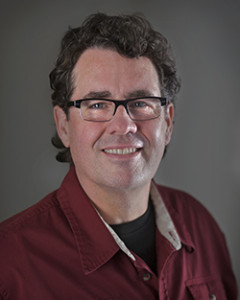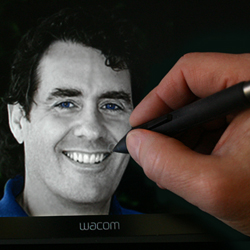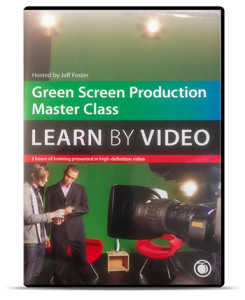
Jeff Foster
For over 20 years VFX pro Foster has been producing and providing training for traditional and digital images, photography, illustration, motion graphics and special effects for DV and Film. Some of his clients include: Tribune Broadcasting, Motorola, McDonnell Douglas, Nestlé, FOX Television, Spike TV, Discovery/TLC, Deluxe Digital, Universal Studios, Lions Gate Films and Disney.
Foster also operates a media production company, Sound Visions Media, where he specializes in producing promotional videos for businesses, artists, musicians and entrepreneurs who have a compelling story to tell.
Basic VFX
Foster is an Adobe Certified Expert. We asked him what basic VFX techniques a beginning filmmaker with little or no budget could use.
“This really depends,” he says, “on the type of film the individual is trying to produce. If you’re looking to do a sci-fi or horror film on a tight budget, then be sure to scale the production/post production to your abilities and resources or else you’ll be the next Ed Wood!”
Foster goes on to say that green screen shots with compositing are typically easy VFX to manage on a limited budget. “This requires good quality green screen production (proper planning, setups, lighting, shooting) to minimize the work needed in post trying to pull a decent key and have a believable result in the final composite.”
Using practical (physical) FX, Foster says, such as makeup, fake blood, miniatures, models, etc. will save you time, rather than trying to create it in post with 3D or roto-painting. “If you’re more proficient at doing this type of work in post, then be sure to plan ahead before shooting to get the correct shots needed. This is why I’m adamant about good storyboards and shot planning.”
Preferred Tools
Industry associates describe Foster as skilled in creating cinematic-quality motion graphics on tight timelines. What are his preferred tools? “I’ve been a long-time After Effects user, so that’s my tool of choice. Between Photoshop and After Effects, I can do about 90% of all my work in that environment, utilizing the built-in tools and plugins available (as of CS5.5).”
Foster also relies heavily on Mocha v2 and a handful of third party plugins, such as RE:Vision FX RSMB (Real Smart Motion Blur), Red Giant’s tools and Boris FX. “There’s little else I need,” he says, “to get believable composites and matte paintings in 2-1/2 D. I’ve been doing work in 4K for feature film productions and this workflow has been great, for a fairly low-budget desktop solution.”
Remaining True to the Story
We wanted to know how Foster’s VFX remain focused on the film’s core story, and avoid distracting from the story.
“The production studios usually have a good VFX director that I work with that gives me plenty of input right up front – before I even bid on the job.” Foster requires seeing the foreground and background plates and getting detailed specifics of their expectations in every single shot.
“Sometimes,” he says, “I need to recreate a scene to match an existing shot.” Example – a day-to-night conversion where Foster needed to do match shots that were done in the late afternoon to existing shots from the night before in a dark alley.
“I often also find other things as I dig into a project while I’m studying a shot to figure out my approach.” Foster catches things like crew and microphones in the background or edges of a shot, or continuity errors from one shot to the next, where a car may be parked in the wrong place. To resolve these, he often just moves or removes the elements because, as he says, “the best work is that which is invisible.”
Self-Taught Artist

Foster’s self portrait
Foster is a self-taught artist. Originally trained as a mechanical engineering draftsman and airbrush illustrator, he has always been attracted to mechanical things and nature. “I never got into human figure drawing,” he says. “I worked in aerospace for several years before ever doing graphics on a computer.” Mechanical illustrations and airbrushed murals made up most of his early career, as well as traditional graphic layout for prepress production and silkscreen printing.
“I designed and painted album covers for ‘glam rock’ heavy metal bands in the 80s and even tackled a wood carving/illustration for one artist.” He says that the traditional tools of drawing and painting easily translated to the digital workflow in the early 90s.
Foster used the original Wacom tablets – “big, clumsy table-top devices”. He says it was still better than painting with “a bar of soap” (mouse). “I was challenged with animation, and explored many processes early on with blue screen production with some pre-vis I did for a VFX house that created the animatronics and puppets used in the movie Tremors.” With a telecine transfer from the 35mm film and using DeBabelizer and Photoshop, Foster says, “I was able to roto out wire-removal and use Utlimatte’s ‘Photofusion’ plugin for Photoshop to create my mattes and composited the frames in After Effects (then still a CoSA product).”
“I added some layers of other elements we shot and the studio loved the conceptual work – though the final post-production was actually completed at Rhythm & Hues. Since then, I’ve only been driven by challenges and desire to just ‘make it work’ with the tools that I have.”
Working With a VFX Pro
When asked if a beginning filmmaker should bring a VFX pro on his team, or try it himself, Foster says it depends on the scope of the project, the budget and the abilities of the entire team. “If you are an indie filmmaker (or student) and your strengths are in directing/shooting/editing, but you suck at the VFX work, then obviously you’ll need to hire/bribe someone else to do the work you need.”

Foster’s book
Asking for favors has its price. “If you have no budget, expect it to take a long, long time until you get everything in place that you need, or improve your own skills to do the work yourself.”
If a filmmaker has a huge budget, then he’ll probably already be part of a team working with a studio that has VFX capabilities. “When I do VFX shots for a feature film,” he says, “they usually know what my specialties are and give me only the shots they know I can produce – which means I don’t do 3D or character rigging/animation – another colleague does that work.”
Foster states that, if there are too many shots for him to accomplish on a project in the allotted timeframe, the studio will also farm some shots out to another artist. “We’re talking about fairly low-budget films here,” he says. “Not real blockbusters, and the VFX are mostly composites or ‘fixes’ of sorts, which require lots of roto work, but not necessarily a need for a big team.”
Foster says he can usually average about one shot a day, sometimes two days if it’s really complex or long (up to 8 seconds in length). Much depends on the time requirements as well as the complexity of the shot. You can see a few examples on his PixelPainter web site or YouTube channel.
Foster’s Media Production Company
In addition to the many post-production projects he does for the feature film industry, Foster also operates a media production company, Sound Visions Media. With an experienced team of industry professionals, Sound Visions Media specializes in producing quality HD promotional videos – from commercials to feature-length documentaries – for businesses, artists, musicians and entrepreneurs who have a compelling story to tell. They’ve branded their award-winning concept as “Documercial,” a method of storytelling in a documentary-style approach to deliver a marketing message for their clients. His documercial video productions won a 2010 Telly Award.
“I love the art of storytelling,” Foster says. “It’s what gets me out of my technical and logical ‘headspace’ that I’m in when doing VFX/post production work.” Foster has been shooting more for documentaries, where getting people to talk about themselves comfortably in front of a camera is really an art. “It takes hours sometimes,” he says, “to get them to loosen-up, and after a while you get the real ‘gold’ – that moment you build your story around.”
Foster uses this approach to create, for book authors, specific infomercials that have a documentary style production, with the authors articulating why they wrote or shared something, as well as a bit about themselves, to get people to care about them, and not only the book or its contents.
“Don’t get me wrong,” he says. “We’ll still do hard-sell commercial work and we crank that out all the time, but if there’s a story to be told, I’d really prefer that approach.”
Capabilities
Foster’s VFX company is PixelPainter: specializing in video production; VFX/roto/compositing; motion graphics; photography; and digital painting.
Examples of his “documercial” product can be seen at SoundVisionsMedia.
Jeff Foster is an accomplished trainer and author. Among his books is The Green Screen Handbook.
